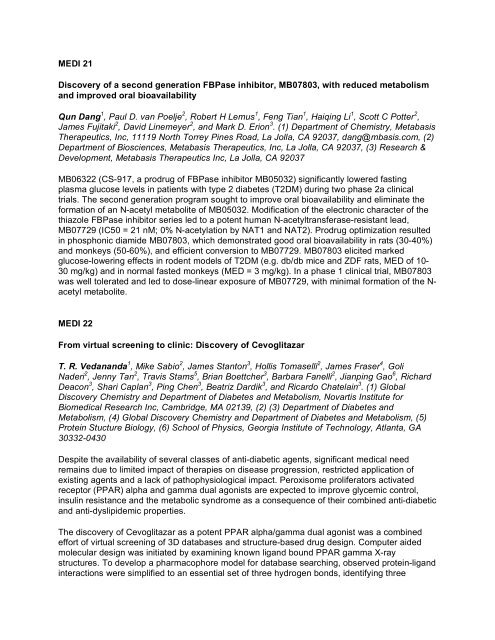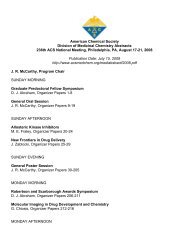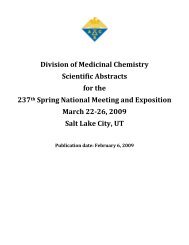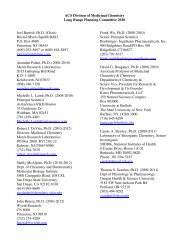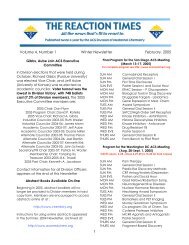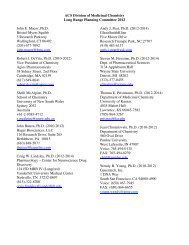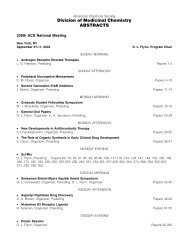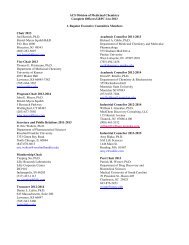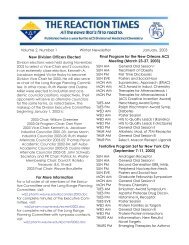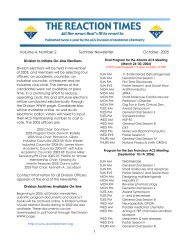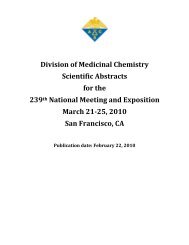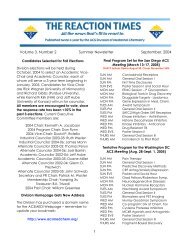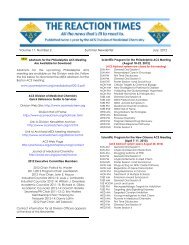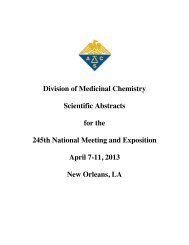Division of Medicinal Chemistry Abstracts-235th ACS National ...
Division of Medicinal Chemistry Abstracts-235th ACS National ...
Division of Medicinal Chemistry Abstracts-235th ACS National ...
- No tags were found...
You also want an ePaper? Increase the reach of your titles
YUMPU automatically turns print PDFs into web optimized ePapers that Google loves.
MEDI 21<br />
Discovery <strong>of</strong> a second generation FBPase inhibitor, MB07803, with reduced metabolism<br />
and improved oral bioavailability<br />
Qun Dang 1 , Paul D. van Poelje 2 , Robert H Lemus 1 , Feng Tian 1 , Haiqing Li 1 , Scott C Potter 2 ,<br />
James Fujitaki 2 , David Linemeyer 2 , and Mark D. Erion 3 . (1) Department <strong>of</strong> <strong>Chemistry</strong>, Metabasis<br />
Therapeutics, Inc, 11119 North Torrey Pines Road, La Jolla, CA 92037, dang@mbasis.com, (2)<br />
Department <strong>of</strong> Biosciences, Metabasis Therapeutics, Inc, La Jolla, CA 92037, (3) Research &<br />
Development, Metabasis Therapeutics Inc, La Jolla, CA 92037<br />
MB06322 (CS-917, a prodrug <strong>of</strong> FBPase inhibitor MB05032) significantly lowered fasting<br />
plasma glucose levels in patients with type 2 diabetes (T2DM) during two phase 2a clinical<br />
trials. The second generation program sought to improve oral bioavailability and eliminate the<br />
formation <strong>of</strong> an N-acetyl metabolite <strong>of</strong> MB05032. Modification <strong>of</strong> the electronic character <strong>of</strong> the<br />
thiazole FBPase inhibitor series led to a potent human N-acetyltransferase-resistant lead,<br />
MB07729 (IC50 = 21 nM; 0% N-acetylation by NAT1 and NAT2). Prodrug optimization resulted<br />
in phosphonic diamide MB07803, which demonstrated good oral bioavailability in rats (30-40%)<br />
and monkeys (50-60%), and efficient conversion to MB07729. MB07803 elicited marked<br />
glucose-lowering effects in rodent models <strong>of</strong> T2DM (e.g. db/db mice and ZDF rats, MED <strong>of</strong> 10-<br />
30 mg/kg) and in normal fasted monkeys (MED = 3 mg/kg). In a phase 1 clinical trial, MB07803<br />
was well tolerated and led to dose-linear exposure <strong>of</strong> MB07729, with minimal formation <strong>of</strong> the N-<br />
acetyl metabolite.<br />
MEDI 22<br />
From virtual screening to clinic: Discovery <strong>of</strong> Cevoglitazar<br />
T. R. Vedananda 1 , Mike Sabio 2 , James Stanton 3 , Hollis Tomaselli 2 , James Fraser 4 , Goli<br />
Naderi 2 , Jenny Tan 2 , Travis Stams 5 , Brian Boettcher 3 , Barbara Fanelli 2 , Jianping Gao 6 , Richard<br />
Deacon 3 , Shari Caplan 3 , Ping Chen 3 , Beatriz Dardik 3 , and Ricardo Chatelain 3 . (1) Global<br />
Discovery <strong>Chemistry</strong> and Department <strong>of</strong> Diabetes and Metabolism, Novartis Institute for<br />
Biomedical Research Inc, Cambridge, MA 02139, (2) (3) Department <strong>of</strong> Diabetes and<br />
Metabolism, (4) Global Discovery <strong>Chemistry</strong> and Department <strong>of</strong> Diabetes and Metabolism, (5)<br />
Protein Stucture Biology, (6) School <strong>of</strong> Physics, Georgia Institute <strong>of</strong> Technology, Atlanta, GA<br />
30332-0430<br />
Despite the availability <strong>of</strong> several classes <strong>of</strong> anti-diabetic agents, significant medical need<br />
remains due to limited impact <strong>of</strong> therapies on disease progression, restricted application <strong>of</strong><br />
existing agents and a lack <strong>of</strong> pathophysiological impact. Peroxisome proliferators activated<br />
receptor (PPAR) alpha and gamma dual agonists are expected to improve glycemic control,<br />
insulin resistance and the metabolic syndrome as a consequence <strong>of</strong> their combined anti-diabetic<br />
and anti-dyslipidemic properties.<br />
The discovery <strong>of</strong> Cevoglitazar as a potent PPAR alpha/gamma dual agonist was a combined<br />
effort <strong>of</strong> virtual screening <strong>of</strong> 3D databases and structure-based drug design. Computer aided<br />
molecular design was initiated by examining known ligand bound PPAR gamma X-ray<br />
structures. To develop a pharmacophore model for database searching, observed protein-ligand<br />
interactions were simplified to an essential set <strong>of</strong> three hydrogen bonds, identifying three


